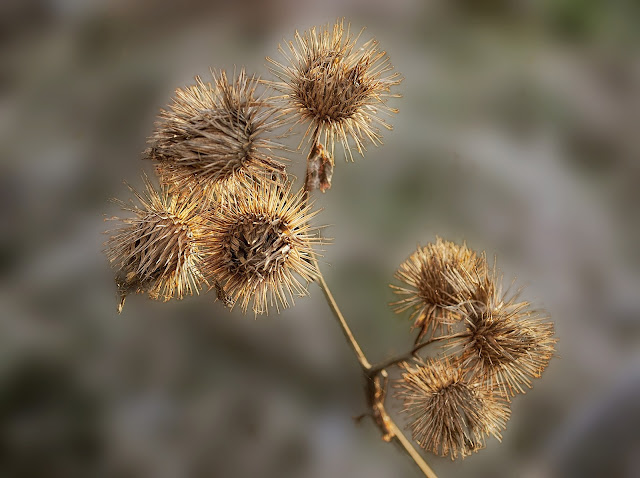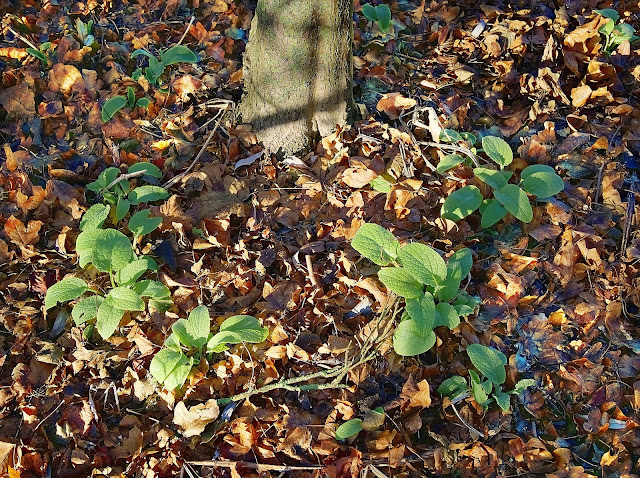Entirely
appropriately for a post published in January, this
article looks back at the last seeds and fruit of the old year, and the
first green shoots of the plants which will eventually flower in the
spring of the new year.
 |
| Cabaret de Oiseaux - 2 January 2017 The dawning sun on a new day in a new year provides a suitably dramatic backdrop to the seed heads of teasels from last year. |
Cabaret des Oiseaux (or more prosaically teasel)
What a wonderful name for a plant – a spectacle of birds – if my schoolboy French is correct. With a name like that doesn't the plant look even more majestic, and can't you just see a cloud of goldfinches feasting on the seed heads? It presumably gets this name from the birds feasting on its seed heads.
Besides that name, the English 'teasel', or 'gypsy comb', or 'brush and comb', sound functional and unimaginative, all derived from the use of the seed head to tease or raise the nap of woollen cloth. Somehow, such names drain the plant of its stature and becomes just another brown plant with an industrial use. Yet, in this most drab time of year, the teasels are impressive, standing very upright, seeming to challenge the weather to do its worst and blow them down.
Teasels are not widespread in Milton Country Park, but a couple of clumps in the Orchard are particularly noticeable as they are growing on top of a small bank, where these photographs were taken.
Burdock
 |
| Burdock Fruit - 5 January 2017 Non-descript brown fruit easily overlooked, not so easily picked off clothing. |
Burdock
is another plant whose fruit are conspicuous at this time of the
year, although not necessarily for the right reasons. They attach
themselves with their natural Velcro to anything and everything that
passes.
Unlike teasel, burdoch has attracted a host of imaginative English names besides burdock (bur a knot of wool, and dock a plant). Along with Herrif, Airup or Aireve, derived from Anglo Saxon and mean hedge robber, other names include: personata, happy major, clot bur, fox's clote, beggars buttons, cockle bur, Robin Hood's rhubarb, and love's leaves. These last two referring to the shape of its leaves.
Burdoch first featured in this blog in September and at that time, I mentioned that it was the inspiration for Velcro, and its use for dandelion burdock cordial. But there is more to burdock in folklore than a zip and a drink.
Firstly,
there is burryman: a man completely covered in burdock burrs who
parades the streets of South Queensferry, Lothian, on the second
Friday in August every year. The origin and reasons for this
ritual, which is credited with being at least seven hundred years old
and may be well be thousands of years old, have been forgotten, and
we are left with theories ranging from warding off evil spirits to
bringing luck for the forthcoming herring fishing season.
Secondly, burdock has been used medicinally for a wide range of conditions including skin problems, rheumatism, and cancer. It is also a liver tonic and a diuretic.
Finally, and a little whimsically, knights in the middle ages rode into battle wearing a sprig of burdock for protection!
Unlike teasel, burdoch has attracted a host of imaginative English names besides burdock (bur a knot of wool, and dock a plant). Along with Herrif, Airup or Aireve, derived from Anglo Saxon and mean hedge robber, other names include: personata, happy major, clot bur, fox's clote, beggars buttons, cockle bur, Robin Hood's rhubarb, and love's leaves. These last two referring to the shape of its leaves.
Burdoch first featured in this blog in September and at that time, I mentioned that it was the inspiration for Velcro, and its use for dandelion burdock cordial. But there is more to burdock in folklore than a zip and a drink.
Secondly, burdock has been used medicinally for a wide range of conditions including skin problems, rheumatism, and cancer. It is also a liver tonic and a diuretic.
Finally, and a little whimsically, knights in the middle ages rode into battle wearing a sprig of burdock for protection!
Gelder Rose and a Hint of Autumn
 |
| Gelder Rose Berries - 20 December 2016 The bright red berries are almost lost among the surrounding branches |
At this time of year, the trees are bare, and most of the berries have fallen or been eaten by the birds, the remaining berries give the bushes a hint of autumn, an ephemeral blush of red, a barely discernible shimmy of colour. In strong sunlight, at a distance, the bush looks quite red, but close up the fruit are few and far between and overwhelmed by the bare brown branches.
So it was with these gelder rose berries, visible at a distance as a faint reddening of the hedge, closer up there were just enough, and were bright enough, to catch the eye.
Last Apples
 |
| Last Apples - 11 December 2016 A few apples still hanging on high in the branches of this tree |
I was really surprised to find any apples at all still on the tree, but, as this image shows, high up in one tree there was still quite a crop. A fact that speaks volumes for the mild and benign autumn that we have had.
First Shoots
 |
| Comfrey - 28 December 2016 Comfrey plants have already grown enough to be clearly visible above the leaf litter. |
On a grey December day, walking on a carpet of fallen leaves, among trees with bare branches, and no colour anywhere, it is easy to believe that nature has shut down, gone to bed, for the winter. Yet, already, there are plenty of signs of spring in the park. Plants like this patch of comfrey are easily visible above the layers of dead leaves. Also much in evidence are young cow parsley seedlings, each a couple of inches high. They will remain almost dormant, growing only very slowly throughout the winter, until April or May, when they seem to grow four feet in a matter of days, and cover the countryside with white frothy flowers.
Look
more closely at the leaf litter and it is not hard to spot much
smaller seedlings, with just two or four leaves, pushing their way
up. It is difficult to believe that these plants, so small and
tender, will survive the frost and snow of winter and blossom next
spring.
Further Reading
Teasels:Plants for a Future Dipsacus fullonum
A Guide to Wild Flowers of woodland and hedgerow Teasels
Teasel Magic and Lyme Spirochaetes
Teasel Plant Lore
Teasel Wildflower Folklore Series
Burdock
The Burryman
Encyclopaedia of Giants and Humanoids in Myth, Legend and Folklore
Burdock Plant Lore
A Modern Herbal Burdock
Love Leaves: Clingy Burdock
More on Burdock for the Month of February
Next: Fungi


No comments:
Post a Comment